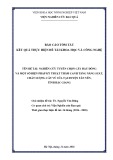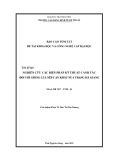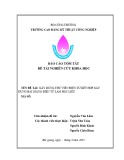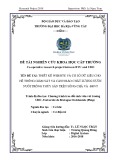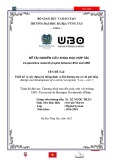
ĐẠI HỌC ĐÀ NẴNG
TRƯỜNG ĐẠI HỌC BÁCH KHOA
BÁO CÁO TỔNG KẾT
ĐỀ TÀI KHOA HỌC VÀ CÔNG NGHỆ CẤP ĐẠI HỌC
ĐÀ NẴNG
NGHIÊN CỨU XÂY DỰNG BỘ CƠ SỞ DỮ LIỆU
MƯA CỰC HẠN PHỤC VỤ GIẢM NHẸ THIÊN TAI
TRÊN ĐỊA BÀN MỘT SỐ TỈNH MIỀN TRUNG
VÀ TÂY NGUYÊN
Mã số: B2016-ĐN02-02
Chủ nhiệm đề tài: PGS. TS NGUYỄN CHÍ CÔNG
Tham gia: ThS NGUYỄN VĨNH LONG
Đà Nẵng, 2019



INFORMATION ON RESEARCH RESULTS
1. General information:
Project title: Study to build an extreme rainfall database for
disaster mitigation in the Central and Highlands, Vietnam.
Code number: B2016-ĐN02-02
Coordinator: Nguyen Chi Cong
Implementing institution: The University of Danang-
University of Science and Technology
Duration: from 9/2016 to 9/2018
2. Objective(s): The project uses a regional approach in
frequency analysis of rainfall to build an extreme rainfall database
and to actively control natural disasters in the Central and Highlands,
Vietnam.
3. Creativeness and innovativeness: Apply a regional
method for 75 rainfall gauges in the Central and Highlands, to build
an extreme rainfall database and to build a map of extreme rainfall
distribution with high reliability.
4. Research results: The project has achieved three main
results: (i) to estimate an extreme rainfall database of 75 rain gauges
in a study area based on regional rainfall analysis; (ii) to build a map
of extreme rainfall distribution for the Central and Highlands,
Vietnam; (iii) Application of this map to develop disaster risk map
due to heavy rainfall for provinces in the Central and Highlands,
Vietnam.
5. Products: The project has achieved the following products:
(i) serve in postgraduate training with three master theses
successfully defended; (ii) publish scientific papers with four articles
published in national journals and conferences; (iii) application of
regional method for rainfall data in the Central and Highlands,
Vietnam.
6. Transfer alternatives, application institutions, impacts
and benefits of research results: The results will be transferred free
to the Technical Center for Disaster Prevention in the Central and
Highlands at 102 Yen Bai street, Hai Chau district, Da Nang city.

Trang 1
MỤC LỤC
MỞ ĐẦU ................................................................................................ 2
Tính cấp thiết của đề tài: ......................................................................... 2
Mục tiêu đề tài: ....................................................................................... 2
Đối tượng và phạm vi nghiên cứu: ......................................................... 3
Cách tiếp cận và phương pháp nghiên cứu: ............................................ 3
CHƯƠNG 1: TỔNG QUAN TÌNH HÌNH KHÍ HẬU VÙNG NGHIÊN
CỨU ........................................................................................................ 3
1.1.Đặc điểm khí hậu khu vực nghiên cứu ............................................. 3
1.2.Hiện trạng các trạm đo mưa vùng nghiên cứu .................................. 3
CHƯƠNG 2: PHƯƠNG PHÁP NGHIÊN CỨU .................................... 4
2.1.Phương pháp phân chia vùng đồng nhất dữ liệu mưa ngày .............. 5
2.2.Phương pháp kiểm tra tính đồng nhất mẫu dữ liệu ........................... 5
2.3.Phương pháp phân tích tần suất mưa vùng ....................................... 5
2.4.Phương pháp nội suy mưa................................................................. 5
CHƯƠNG 3: XÂY DỰNG BỘ CƠ SỞ DỮ LIỆU MƯA CỰC HẠN ... 5
3.1. Cơ sở dữ liệu vùng nghiên cứu ........................................................ 5
3.2. Kết quả phân chia vùng đồng nhất ................................................... 5
3.3. Kết quả phân tích tần suất mưa vùng và bộ cơ sở dữ liệu mưa thời
đoạn ......................................................................................................... 9
3.4. Kết quả bản đồ mưa thời đoạn ....................................................... 10
CHƯƠNG 4: XÂY DỰNG BẢN ĐỒ RỦI RO THIÊN TAI DO MƯA
LỚN ...................................................................................................... 11
4.1.Cơ sở pháp lý và sự cần thiết xây dựng bản đồ rủi ro thiên tai....... 11
4.2.Lựa chọn kịch bản xây dựng bản đồ rủi ro thiên tai do mưa lớn .... 11
4.3.Các bước xây dựng bản đồ cấp độ rủi ro thiên tai do mưa lớn ....... 13
4.4. Kết quả bản đồ rủi ro thiên tai do mưa lớn .................................... 13


![Mẫu Thuyết minh tóm tắt đề tài nghiên cứu khoa học cấp trường [chuẩn nhất]](https://cdn.tailieu.vn/images/document/thumbnail/2025/20250318/tuongmotranh/135x160/8151742262471.jpg)
